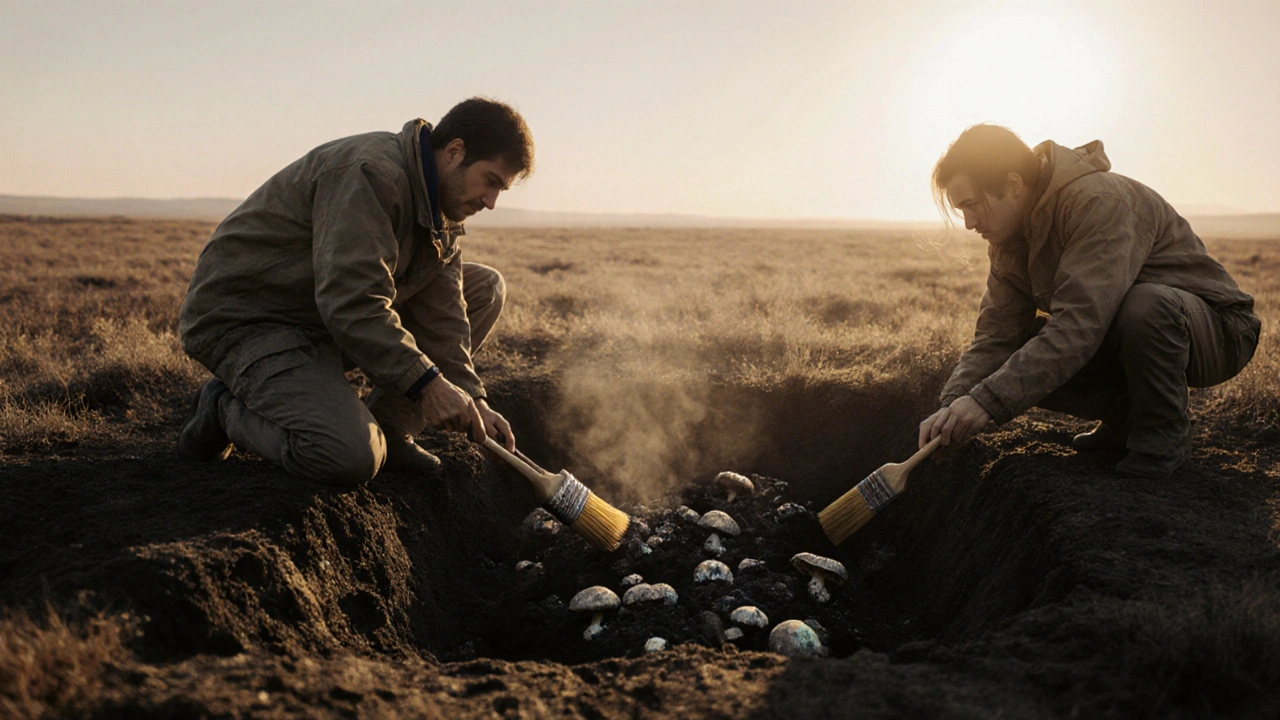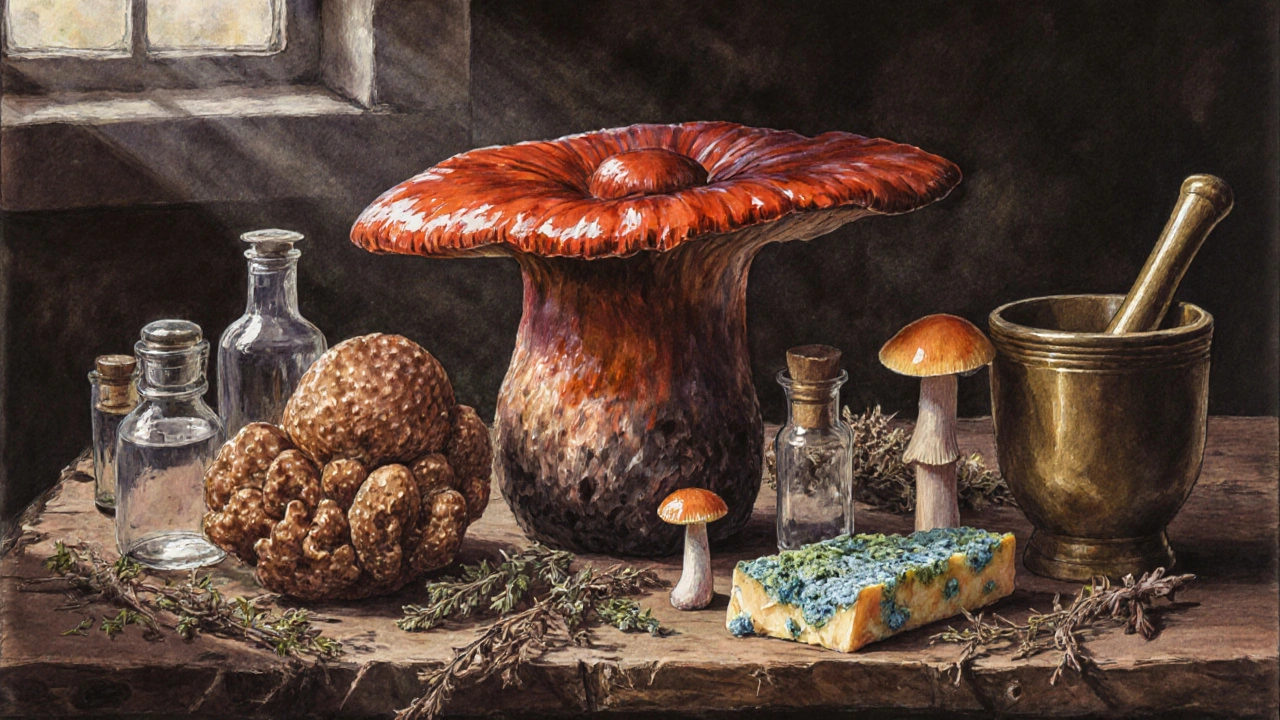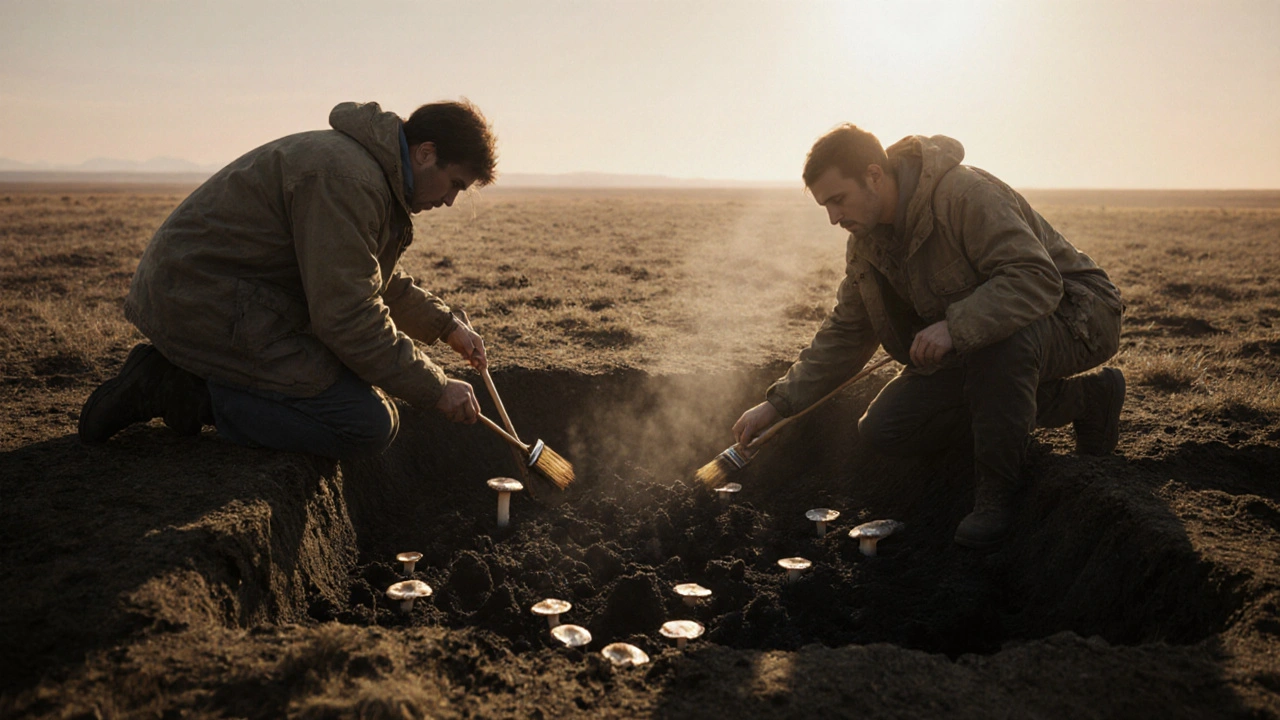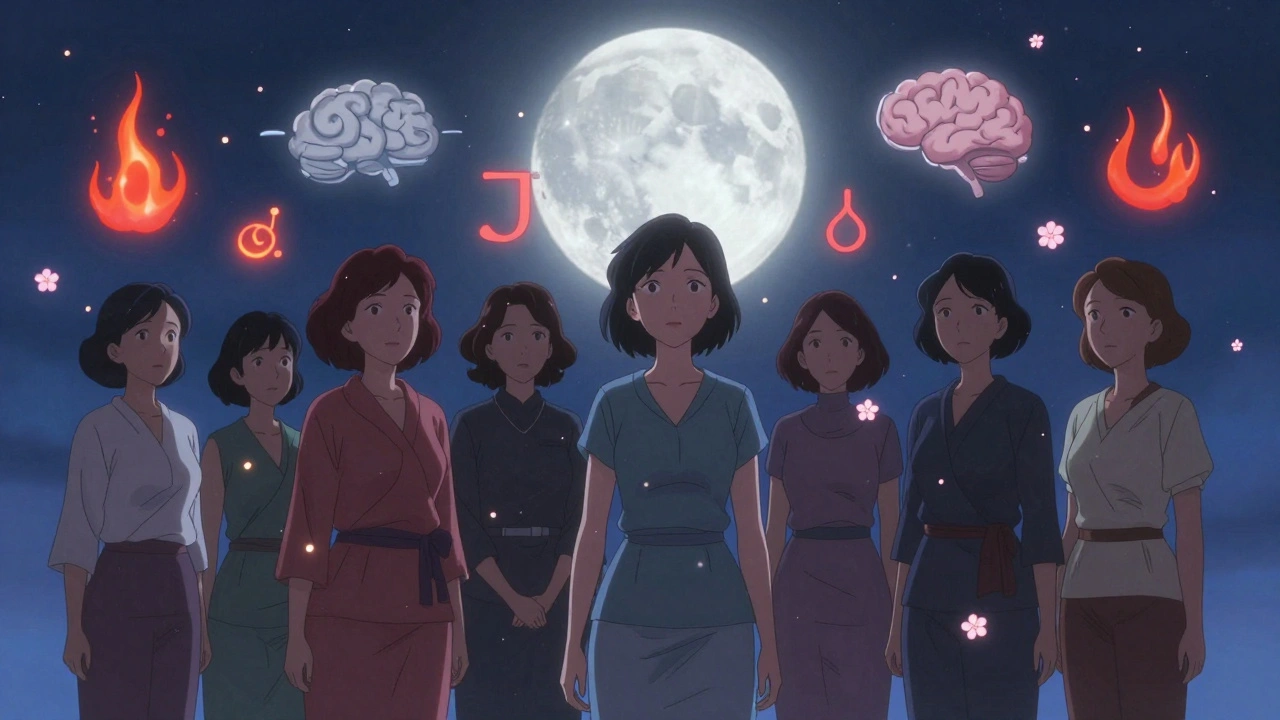The History of Fungus in Traditional Medicine - From Ancient Remedies to Modern Science

Medicinal Fungus Safety Checker
Check Medicinal Fungus Interactions
This tool helps identify potential interactions between common medicinal fungi and prescription medications. Always consult with a healthcare provider before using medicinal fungi.
For centuries, humans have turned to the forest floor and the damp corners of their world to find healing power. Medicinal fungi are a group of mushrooms and molds that have been harvested, boiled, and powdered to treat everything from coughs to fatigue. This article walks you through the earliest records, the iconic species that shaped folk healing, how those recipes survived through the ages, and what modern science says about their effectiveness. By the end you’ll see why fungus in traditional medicine is more than a curious footnote - it’s a living legacy.
Ancient Roots: Early Uses of Fungi Across Cultures
Archaeological digs in Siberia have uncovered charcoal pits that once held Reishi mushroom (Ganoderma lucidum) fragments dating back 2,000 years. Chinese texts such as the "Shennong Ben Cao Jing" (Divine Farmer’s Materia Medica) listed Reishi as the "spirit plant" that promotes longevity.
In the misty highlands of Ethiopia, the ancient Oromo people chewed the bruised caps of Agarikon (Fomitopsis officinalis) to stave off infections. The fungal mycelium was believed to carry the spirit of the forest, granting both physical and spiritual protection.
Meanwhile, indigenous peoples of North America harvested the orange‑brown conks of Chaga (Inonotus obliquus) and brewed them into tea to treat gastrointestinal issues. Early explorers wrote in their journals that the brew “strengthened the gut and lifted the spirit.”
These accounts illustrate a common pattern: fungi were prized for their immune‑boosting, anti‑inflammatory, and adaptogenic qualities, even if the people describing them lacked modern biochemical language.

Iconic Medicinal Fungi and Their Stories
Below is a snapshot of the most celebrated fungi that have survived in traditional pharmacopeias.
| Common Name | Scientific Name | Traditional System | Primary Active Compounds | Usual Health Claim |
|---|---|---|---|---|
| Reishi | Ganoderma lucidum | Traditional Chinese Medicine (TCM) | Polysaccharides, triterpenes | Longevity, stress reduction |
| Chaga | Inonotus obliquus | Russian folk medicine | Betulinic acid, melanin | Immune support, antioxidant |
| Turkey Tail | Trametes versicolor | Traditional Chinese, Japanese Kampo | Polysaccharide‑K (PSK) | Cancer adjunct, gut health |
| Cordyceps | Cordyceps sinensis | TCM, Tibetan medicine | Cordycepin, adenosine | Energy, respiratory support |
| Psilocybin Mushrooms | Psilocybe cubensis | Indigenous Mesoamerican rituals | Psilocybin, baeocystin | Spiritual insight, mood regulation |
| Agarikon | Fomitopsis officinalis | Ethiopian folk medicine | Flavonoids, phenolics | Antibiotic, antiviral |
| Penicillium (mold) | Penicillium chrysogenum | European herbal lore | Penicillin | Infection control |
Each of these fungi earned a place in remedies because local healers observed consistent benefits. For example, the Himalayan monks that used Cordyceps reported heightened stamina during long meditation sessions, a claim still echoed in modern performance‑enhancing research.
From Scrolls to Shelves: How Knowledge Was Preserved
Traditional medicine relied on oral transmission, illustrated manuscripts, and later printed herbals. The Chinese “Bencao Gangmu” (Compendium of Materia Medica), compiled in the 16th century by Li Shizhen, dedicated several chapters to fungi, describing collection seasons, preparation methods, and dosage ranges.
In Europe, the medieval “Physic Gardens” of monasteries cultivated Penicillium as a source of “blue mold” for cheese making. While monks were unaware of antibiotics, they recorded anecdotes of wound healing that later physicians cited when exploring microbial therapy.
Indigenous peoples kept knowledge within community circles, using songs and symbolic tattoos to indicate which mushroom was safe to eat. The loss of language in many tribes has endangered this wisdom, prompting modern ethnobotanists to record elder testimonies before they disappear.
The shift from oral to written tradition also introduced standardization. Dosage tables became more precise, and preparation techniques-such as double‑steaming Reishi for 12 hours-were codified to maximize extraction of bioactive polysaccharides.

Modern Science Meets Ancient Wisdom
When the first clinical trials on Reishi appeared in the 1990s, researchers measured immune cell proliferation and found a 23% increase in NK‑cell activity among participants. Similar studies on Chaga showed a reduction in oxidative DNA damage markers by 15% after eight weeks of daily tea consumption.
The Japanese cancer community embraced Turkey Tail’s PSK after a 1990s multi‑center trial demonstrated a 30% improvement in 5‑year survival for gastric cancer patients receiving standard chemotherapy plus PSK. This success led to PSK being approved as an adjuvant therapy in Japan.
Clinical evidence for Cordyceps focuses on aerobic performance. A 2021 double‑blind study reported that elite cyclists who took Cordyceps extract improved VO₂ max by an average of 5% compared to placebo.
Psilocybin, once a sacramental mushroom, re‑entered mainstream research in the 2010s. Controlled trials have shown that a single guided dose can reduce depressive symptoms in up to 70% of participants, prompting FDA “breakthrough therapy” designation for several mental‑health indications.
These modern findings don’t rewrite the past; they validate the intuition of healers who noticed patterns long before laboratory equipment existed.
Risks, Sustainability, and Ethical Considerations
Even natural remedies carry potential drawbacks. Wild‑harvested Reishi can accumulate heavy metals if grown near polluted rivers. Over‑collection of Cordyceps in the Tibetan plateau has driven prices sky‑high and threatened alpine ecosystems.
To mitigate these issues, many producers now rely on cultivated mycelium in sterile bioreactors, allowing consistent potency while reducing pressure on wild populations. However, cultivation can alter the profile of secondary metabolites; consumers seeking a “wild” effect should verify third‑party testing results.
Ethical sourcing also matters. The knowledge of many medicinal fungi belongs to Indigenous peoples. Fair‑trade agreements and benefit‑sharing models ensure that communities receive royalties when their traditional formulas become commercial products.
Finally, self‑medication without professional guidance can lead to interactions with prescription drugs-especially with fungi that affect cytochrome P450 enzymes, such as Reishi. Always discuss supplementation with a qualified health practitioner.

Key Takeaways
- Medicinal fungi have been used for at least two thousand years across Chinese, European, African, and Indigenous American traditions.
- Reishi, Chaga, Turkey Tail, Cordyceps, Psilocybin mushrooms, Agarikon, and Penicillium are the most documented species.
- Modern clinical trials confirm many traditional claims, especially for immune modulation, antioxidant activity, and mental‑health benefits.
- Wild harvesting poses ecological and safety risks; cultivated alternatives and ethical sourcing are becoming the norm.
- Consulting healthcare professionals is essential to avoid drug interactions and to determine appropriate dosages.
Frequently Asked Questions
Which medicinal fungus is best for boosting immunity?
Reishi and Turkey Tail are the top choices. Reishi’s polysaccharides stimulate NK‑cell activity, while Turkey Tail’s PSK has been used alongside chemotherapy to enhance immune response.
Can I grow these fungi at home for medicinal use?
Cultivation kits are widely available for Reishi, Cordyceps, and Lion’s Mane. Home‑grown mushrooms can match commercial potency if you follow sterile techniques and maintain proper temperature and humidity.
Are there any contraindications with prescription medication?
Yes. Reishi, for instance, may thin blood and interact with anticoagulants. Cordyceps can affect insulin levels, so diabetic patients should monitor glucose. Always check with a doctor before adding medicinal fungi to your regimen.
How reliable are the traditional dosage recommendations?
Traditional texts often suggest gram‑level daily doses, but modern extracts can be far more concentrated. A safe approach is to start with the lowest recommended dose on the product label and adjust based on tolerance and effect.
Is there scientific proof that psilocybin mushrooms help with depression?
Recent randomized controlled trials report remission rates of 60‑70% after two supervised sessions. The FDA has granted breakthrough‑therapy status, indicating strong evidence of benefit, though use remains limited to clinical settings.






Comments
anshu vijaywergiya
October 12, 2025 AT 13:09Imagine the forest whispering its secrets across centuries, and we, humble seekers, finally learning to listen. The ancient healers didn't just stumble upon fungi; they cultivated a deep respect for the living mycelium that threads ecosystems together. Today, that reverence can guide us to more inclusive health practices, where every culture's botanical heritage finds a seat at the table. When we celebrate Reishi not only as a supplement but as a cultural bridge, we honor the Indigenous keepers of that knowledge. Let’s keep the dialogue open, welcoming newcomers while safeguarding the wisdom of those who first taught us to brew a calming tea under moonlight.
In this shared journey, we become co‑authors of a living manuscript that spans continents and ages.
ADam Hargrave
October 26, 2025 AT 10:29From a grand philosophical standpoint, the notion that a mushroom can grant "longevity" feels almost mythic-like the ancient Greeks believing in ambrosia. Yet here we are, dissecting polysaccharides like they're the new philosophers of health. 😏 One could argue that the modern frenzy around fungi is just a capitalist re‑branding of age‑old forest folklore, dressed up in glossy packaging for the Western consumer.
Still, the biochemical pathways are real, even if the marketing hype sometimes borders on the theatrical.
Rohit Poroli
November 9, 2025 AT 07:49When we parse the immunomodulatory effects of Ganoderma lucidum at a molecular level, several key pathways emerge. First, the β‑glucans interact with Dectin‑1 receptors on macrophages, triggering a cascade that elevates NF‑κB activity and consequently upregulates cytokine production. This results in a measurable increase in NK‑cell cytotoxicity, which clinical trials have quantified at roughly 23 % over baseline.
Second, triterpenoids such as ganoderic acids inhibit 5‑α‑reductase, offering ancillary benefits for androgen‑related conditions.
From a pharmacokinetic perspective, the polysaccharide matrix exhibits low oral bioavailability but can be optimized via encapsulation technologies, enhancing systemic exposure.
Third, the synergistic effect observed when combining Turkey Tail-derived PSK with conventional chemotherapeutics aligns with the concept of adjuvant immunotherapy, as evidenced by improved five‑year survival metrics in gastric cancer cohorts.
Moreover, the antioxidant capacity of Inonotus obliquus, attributable to melanin and betulinic acid, attenuates oxidative DNA lesions, a finding corroborated by reduced 8‑OHdG markers in longitudinal studies.
On the metabolic front, Cordyceps sinensis contributes cordycepin, which modulates adenosine receptors, thereby influencing aerobic respiration efficiency-a mechanism that underpins the documented VO₂ max enhancement in elite athletes.
Importantly, the cytochrome P450 interaction profile of these fungi is heterogeneous; Reishi, for instance, induces CYP2C9, necessitating caution when co‑administered with warfarin.
In contrast, Chaga exhibits minimal enzyme induction, presenting a comparatively safer adjunct for patients on polypharmacy regimens.
From an ethnopharmacological lens, the convergence of empirical observations across disparate cultures underscores a conserved bioactivity that modern biochemistry is only now decoding.
Finally, sustainable cultivation via solid‑state fermentation mitigates wild‑harvest pressures while preserving the metabolite spectrum essential for therapeutic fidelity.
Jessica Tang
November 23, 2025 AT 05:09If you’re considering adding medicinal fungi to your routine, start with a reputable source that provides third‑party testing results. For Reishi, a daily dose of 1–2 grams of powdered fruiting body is typical, but if you’re using an extract, follow the manufacturer’s concentration guidelines. Chaga tea can be brewed with 5 grams of chipped material steeped for 15–20 minutes; many users report a subtle earthy flavor that mellows over time.
When buying Cordyceps, look for a product that specifies the proportion of cordycepin, as that is the active marker most linked to performance benefits. Remember to rotate your fungi-cycling every 4‑6 weeks can help prevent tolerance buildup.
If you’re on prescription medication, especially blood thinners or diabetes drugs, consult a healthcare professional before starting, as interactions have been documented. Stay hydrated, monitor your body's response, and adjust dosage as needed.
Matt Quirie
December 7, 2025 AT 02:29It is essential to acknowledge that medicinal fungi, while natural, can interact with pharmaceutical agents; therefore, professional guidance is recommended. Reishi may potentiate anticoagulant effects, leading to an increased risk of bleeding; similarly, Cordyceps may influence insulin sensitivity, which could affect glycemic control in diabetic patients. Prior to initiating any fungal supplement regimen, obtain a thorough medication review from a qualified practitioner. Additionally, verify that the product adheres to Good Manufacturing Practices to ensure purity and potency. This cautious approach helps mitigate adverse events while allowing patients to benefit from the therapeutic properties of these organisms.